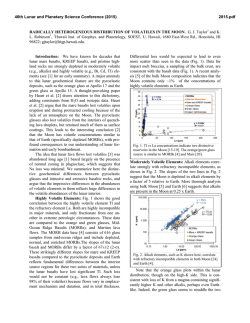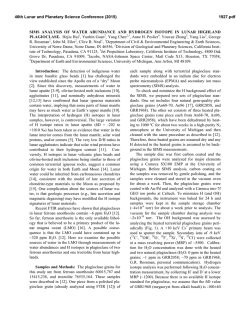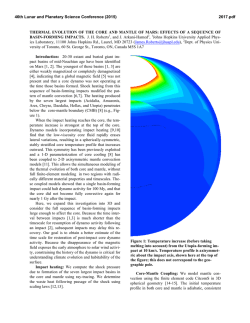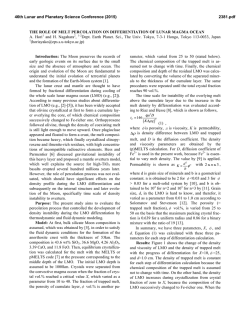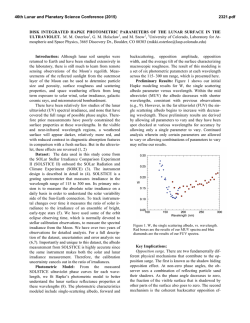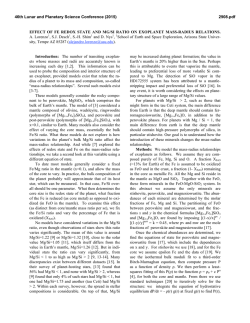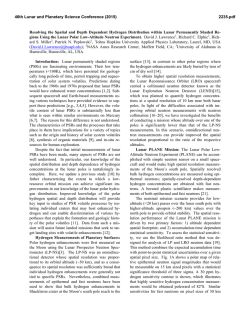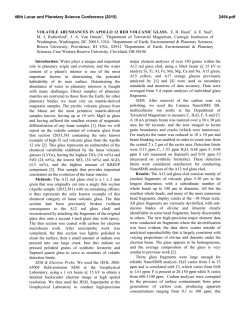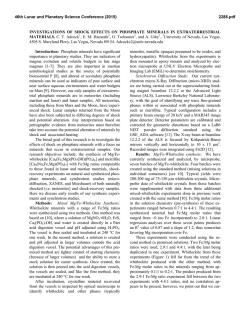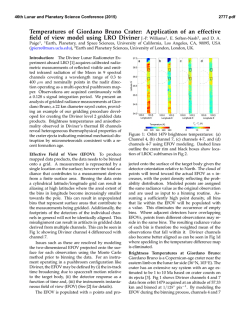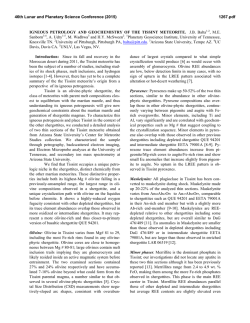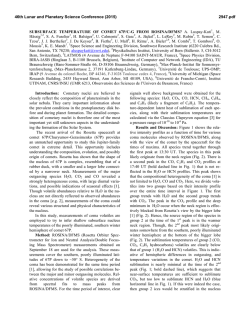
(F, Cl, AND H) IN THE BULK SILICATE MOON
46th Lunar and Planetary Science Conference (2015) 1717.pdf ABUNDANCES AND DISTRIBUTIONS OF LITHOPHILE MAGMATIC VOLATILES (F, Cl, AND H) IN THE BULK SILICATE MOON: A COMPARISON BETWEEN ESTIMATES FROM SAMPLES AND INFERENCES FROM LMO MODELING. F. M. McCubbin1, S. M. Elardo2, K. E. Vander Kaaden1, J. W. Boyce3 and C. K. Shearer1, 1Institute of Meteoritics, 1 University of New Mexico, MSC03-2050, Albuquerque, NM 87131, 2Geophysical Laboratory, Carnegie Institution of Washington, 5251 Broad Branch Rd. NW Washington, DC 20015, 3Department of Earth, Planetary, and Space Sciences, University of California, Los Angeles, California 90095 ([email protected]). Introduction In recent years, there has been a focused effort to determine the abundances and distributions of magmatic volatiles in lunar materials, which started in 2007 when two groups independently began reassessing the hydrogen inventory of lunar samples [see 1 for a brief overview]. Since that time, a wide range of estimates for H2O abundances in the lunar interior have emerged, but few of these studies have placed those estimates within the context of models for the thermal and magmatic evolution of the Moon, which is the primary goal of the present study. LMO overview: At the initial stages of lunar differentiation it is widely believed that much, if not all, of the silicate portion of the Moon was molten. This molten mass is referred to as the lunar magma ocean (LMO) [2–3]. Most models of LMO crystallization predict that upon cooling, crystallization commences with early Mg-rich olivine followed by orthopyroxene, which sink to form a stratified lunar cumulate mantle [4–6]. By ~70 % crystallization, when the remaining liquid is Fe-rich and dense, anorthitic feldspar begins to crystallize and float to the surface of the LMO, forming the primary anorthositic crust. The residual LMO liquid continues to crystallize, eventually forming a cumulate layer with abundant FeTi oxides. Continued crystallization of the LMO leads to the residual LMO liquid becoming highly enriched in incompatible lithophile elements, including potassium (K), rare earth elements (REEs), and phosphorous (P). The term urKREEP is used to identify the last 1–2 % of residual LMO liquid [7], and the volatile abundances and volatile isotopic compositions of this liquid are largely unconstrained. Volatiles in urKREEP: urKREEP represents an important lunar volatile reservoir. The incompatible lithophile magmatic volatiles (F, Cl, and H) are likely to be highly enriched in the urKREEP liquid, and hence this liquid may have hosted much of the Moon’s initial inventory of F, Cl, and H (provided they did not degas or become preferentially stored in a volatilebearing mineral phase prior to urKREEP formation). The key to understanding the initial volatile abundances (both relative and absolute) of the Moon at the time of the LMO is through knowing the volatile abundances of urKREEP. Unfortunately, the lunar sample collection (Apollo and Luna returned samples and lunar meteorites) does not contain a sample of the original urKREEP material, and the composition of the KREEP component has only been inferred or estimated from KREEP-rich geochemical signatures in some lunar samples. The highlands magnesian-suite rocks are KREEPrich mafic-ultramafic igneous cumulates that contain apatite. The origin of the parental magmas that produced these cumulates involved the interaction of the earliest-formed Mg-rich olivine-dominated magma ocean cumulates with the primary anorthositic crust and urKREEP liquid [5, 8–10]. The earliest formed Mg-rich olivine-dominated magma ocean cumulates would be very poor in volatiles compared to more evolved pyroxene-rich cumulates based on available silicate-melt partitioning data for volatiles in olivines and pyroxenes [11–15]. Consequently, the volatile signature of any partial melt that formed from early magma ocean cumulates, and hence the partial melts that formed the magnesian suite, would have been overprinted by the volatile signature of urKREEP. Apatites that crystallized from the lunar highlands rocks then would have recorded the volatile signature of their parental liquids, providing a direct measurement of the relative abundances of volatiles in urKREEP, which indicate Cl > H2O ≈ F [16]. The absolute abundance of F in urKREEP was estimated by Treiman et al. [17] to be ~660 ppm. This estimate was made from the F/P ratios in several Luna 16 and 20 soil samples and the abundances of F, Be, and Li in KREEPy soil 14136. By combining this estimate with the relative abundances determined from apatite, McCubbin et al., [18] reported the following urKREEP abundances for F (660 ppm), Cl (1100–1350 ppm), and H2O (300–1250 ppm). Volatiles in the cumulate lunar mantle: Estimates of the abundances of F, Cl, and H2O in the lunar mantle vary substantially, but they consistently indicate that H2O > F >> Cl [16, 18–21]. Absolute abundances for H2O range from 0.3 ppm to 130 ppm, depending on the type of sample or analysis used to make the estimate [18–19]. This either indicates that the lunar mantle has a highly heterogeneous distribution of magmatic volatiles, there is a problem with the methods being employed to estimate the volatile abundances, or both. To assess this question further, we compare the estimates of volatiles in the lunar mantle from sample analysis with what would be expected from lunar magma ocean crystallization. The volatile abundances of the cumulate mantle would have been controlled by three primary factors, 1) the volatile content of the initial LMO liquid 2) the 46th Lunar and Planetary Science Conference (2015) amount of residual liquid that remained trapped within the cumulate pile during LMO crystallization and 3) the partitioning behavior of volatiles between the LMO liquid and the nominally volatile-free phases that crystallized to form the cumulate mantle. Under both scenarios, the lunar mantle would have a heterogeneous distribution of volatiles, with volatile abundances generally decreasing with depth in the precumulate-overturn mantle stratigraphy. If the dominant control on the abundance of volatiles is trapped residual liquid in the cumulate lunar mantle, the cumulate mantle and urKREEP should have similar ratios of volatile incompatible lithophile elements (F, Cl, and H) with much lower abundances in the cumulate mantle compared to the urKREEP liquid. If the abundances of volatiles in the cumulate lunar mantle are primarily controlled by the partitioning behavior of nominally anhydrous phases and melt, volatile abundances in the lunar mantle would not mirror the volatile abundances of urKREEP. In fact, the volatile abundances would vary based on the mantle mineralogy, where olivine-dominant portions of the mantle would have very low abundances of volatiles, given the incompatibility of F, Cl, and OH in olivine under LMO conditions [11–15]. Furthermore, pyroxene-rich portions of the mantle would be highly depleted in Cl relative to F and H2O given the similar pyroxene-melt partitioning relationships for F and OH and the exclusion of Cl in pyroxene due to the large ionic radius of Cl compared to F and OH [11–15]. Based on the estimates of the relative abundances of F, Cl, and H in the lunar mantle and urKREEP, the volatile abundances of the lunar mantle was likely controlled by the partitioning of F, Cl, and H between nominally volatile-free minerals and LMO liquid. This places important constraints on the expected distribution of F, Cl, and H in the lunar mantle during LMO crystallization. LMO modeling of F, Cl, and H: Estimates for F, Cl, and H2O in the lunar mantle were computed based on LMO crystallization modeling results from Elardo et al., [22], which employed the FXMOTR program to simulate bottom-up fractional crystallization of an LMO, assuming that the entire silicate portion of the Moon participated in primordial differentiation. The calculations simulated crystallization in 1 % intervals of a 1060 km (4 GPa) LMO with a lunar primitive upper mantle bulk composition. LMO mineral compositions and modal abundances within the LMO cumulate pile were obtained from the FXMOTR output files and are in general agreement with previous results of LMO crystallization products from modeling and experiments [4–6, 23]. These LMO mineral compositions and modes were used to compute appropriate distribution coefficients for F and H2O during LMO crystallization, and a D value of 0.00015 was used for Cl [19]. The amount of liquid trapped within the cumulate pile during LMO crystallization 1717.pdf also plays an important role on the abundances of volatiles in the mantle source, so we conducted our calculations over a range (0 %, 0.1 %, 0.5, 1 %, 2 %, and 5 %) of values. Using the urKREEP estimate above, the lunar mantle could have had at most 1 % residual liquid trapped within the cumulate pile during LMO crystallization and still maintain the observed relative abundance differences between F, Cl, and H2O between mare and urKREEP sources. Assuming 0.5 % trapped interstitial liquid in the cumulate pile, the urKREEP composition above implies a cumulate lunar mantle with 0.54 ppm F, 0.15–0.61 ppm H2O, and 0.26–0.32 ppm Cl, which is lower than most estimates for volatiles in the lunar mantle from sample analysis. Our estimate of urKREEP may be too low, so we have estimated an upper limit abundance of F, Cl, and H in the bulk lunar mantle assuming the Moon started with a chondritic abundance of F. In this model, the lunar mantle would have ≤ 4.5 ppm F, 5.3 ppm H2O and 2.9 ppm Cl (assuming 0.5 % trapped interstitial liquid). These values are within the range of estimates from lunar samples, but on the lower end of such estimates. Consequently, processes other than LMO crystallization and/or mixing with KREEP are required to explain more than about 5 ppm H2O in the mantle. References: [1] Anand, M. (2010) Earth, Moon and Planets, 107, 65-73. [2] Smith, J.V. et al., (1970) Journal of Geology, 78, 381-405. [3] Wood, J.A., et al. (1970) Proceedings of the Apollo 11 Lunar Science Conference. [4] Elkins-Tanton, L.T., et al., (2002) Earth and Planetary Science Letters, 196, 239-249. [5] Elardo, S.M., et al. (2011) Geochimica et Cosmochimica Acta, 75, 3024-3045. [6] Snyder, G.A., et al., (1992) Geochimica et Cosmochimica Acta, 56, 3809-3823. [7] Warren, P.H. and J.T. Wasson (1979) Reviews of Geophysics, 17, 73-88. [8] Shearer, C.K., et al., (2015) American Mineralogist, 100, 294-325. [9] Shearer, C.K., et al., (2006) Reviews in Mineralogy and Geochemistry, 60, 365-518. [10] Shearer, C.K. and J. Papike, (2005) Geochimica et Cosmochimica Acta, 69, 3445-3461. [11] Aubaud, C., et al., (2004) Geophysical Research Letters, 31, 1-4. [12] Beyer, C., et al., (2012) Earth and Planetary Science Letters, 337, 1-9. [13] Hauri, E.H., et al., (2006) Earth and Planetary Science Letters, 248, 715-734. [14] O'Leary, J.A., et al., (2010) Earth and Planetary Science Letters, 297, 111-120. [15] Tenner, T.J., et al., (2009) Chemical Geology, 262, 42-56. [16] McCubbin, F.M., et al., (2011) Geochimica et Cosmochimica Acta, 75, 5073-5093. [17] Treiman, A.H., et al., (2014) American Mineralogist, 99, 1860-1870. [18] McCubbin, F.M., et al., (2015) American Mineralogist, 100, in press. [19] Hauri, E.H., et al., (2015) Earth and Planetary Science Letters, 409, 252-264. [20] Hauri, E.H., et al., (2011) Science, 333, 213-215. [21] Saal, A.E., et al., (2008) Nature, 454, 192-195. [22] Elardo, S.M., et al., (2015) Earth and Planetary Science Letters, In Review. [23] Elkins-Tanton, L.T. and T.L. Grove, (2011) Earth and Planetary Science Letters, 307, 173–179.
© Copyright 2025
